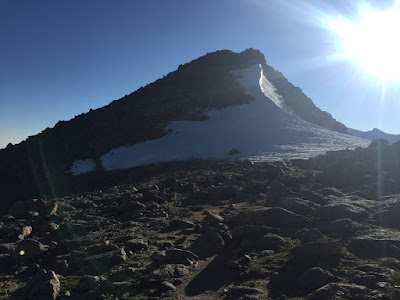But first, we claimed Mount Sniktau, a 13er located near the Loveland Pass.
Mount Sniktau
Sniktau is a short and very beautiful hike with a clear trail all the way to the top of the mountain. The trailhead is easy to access, as it’s located at the crest of the Loveland Pass, right off the side of the highway. The first mile of Sniktau’s trail is a steep, uphill trudge to the top of the ridge. Beyond that, the hike levels off and becomes a pleasant ridge stroll (pleasant, despite the occasionally intense wind) until you reach a false summit, the ascent of which is nothing compared to the trudge of that first mile. The trail does steepen again with the final push to the summit— but the trail remains clear, and the views from the top are well worth it.
We couldn’t have asked for a better “warmup” hike to prepare us for the fourteeners we’d soon be tackling. I use “warmup” with caution— Sniktau should not be taken lightly. Short route or not, this is still a Rocky Mountain summit, and much of the trek is on a high, open ridge.
 |
| Looking down at Loveland Pass |
 |
| Sniktau's summit |
Grays and Torreys
 |
| The (incredibly) miserable road |
We are fans of early starts. As in, extremely early—3 AM early. My dad is always the first to note that he’s a flatlander in his mid sixties, who didn’t discover fourteener hiking till he was 59. He’s not going to be the fastest hiker on the mountain—and neither am I, for that matter. Also, hiking for a couple of hours under a clearly visible band of the Milky Way is an underrated experience clearly not enjoyed by enough people; we are always hiking alone during those first hours.
So yes, we took the Tundra up the miserable road to the trailhead in the dark, small hours of the morning and started our hike up Grays Peak at 3 am. We were hiking alongside the small ridge leading to Grays’ east slopes when the sun began to break above the mountains behind us. Ever-looming Torreys painted in dawn’s orange was truly a remarkable sight.
We kept on, sometimes wondering when we’d begin the final switchbacks up to the summit.
A family of mountain goats ascended the snow below the saddle. The morning brightened.
 |
| But we made it |
A family of mountain goats ascended the snow below the saddle. The morning brightened.
And then we turned that sharp corner right below the saddle and completed the last of the switchbacks. We had Grays' summit to ourselves (!!!!) for a few moments— until we were joined by a few hikers who'd oh so nearly caught up to us.
I took a closer look at the route over to Torreys. The ridge and ascent to Torreys' summit looked at once not so bad and yet much, much more difficult and rugged than described by any guidebook or website. No way we weren’t going over there, we knew, and so we began the descent down to the saddle between the peaks.
My initial impression of the ridge between the two summits was entirely accurate.
It is not a bad hike. At all. To say it’s "easy" to claim these two summits in a day is entirely accurate. Standing atop Grays and looking over at Torreys is nothing like, say, being atop Harvard and gazing out at Columbia. (Been there, didn’t do that). But it’s also fair to say that no pictures or route descriptions do these two mountains justice. They’re both enormous, and the final ascent up Torreys’ slopes is very fun and pretty darned steep.
And as usual with Colorado and its fourteeners, the scenery is Grade-A beautiful.
 |
| Resting |
 |
| The ascent to Torreys with Grays in the background |
 |
| Torreys' summit |
Bierstadt
Again, an early start. The alarm went off at 1:45, and by 3 we were setting out into the marshy willows that consume the trail's first mile.
 |
| Sawtooth & Bierstadt, early |
I greatly appreciated that there were wooden walkways across the marshiest areas, but as it turned out... you might get your feet wet, anyway. There is a creek at the end of the first mile, and on this morning, it was extremely high... and moving. There was no clear way to cross it without risking wet shoes and socks— unless we dared the frigid waters barefooted, which is what we did.
I had an old floppy hat in my backpack that we used to dry our feet off. And thank God for wool socks. I could feel my toes again by the time we were switchbacking up Bierstadt’s lower slopes.
We stopped atop a shoulder below the mountain's summit ridge for a makeshift breakfast of granola, sunflower seeds, and crackers.
The sun took its time breaking over Evans and the Sawtooth.
We didn’t have sunlight beaming down on us until we were picking our way up the class two boulders just below the summit.
Bierstadt was probably the easiest fourteener I’ve done, and it’s also one of my favorites.
I will say: the ridge over to the Sawtooth looked like a ton of fun.
But that’s for another day.
 |
| Looking back at the trailhead |
 |
| Sunlight near the summit push |
 |
| Bierstadt's summit |
 |
| A look back at the Sawtooth and Bierstadt |





